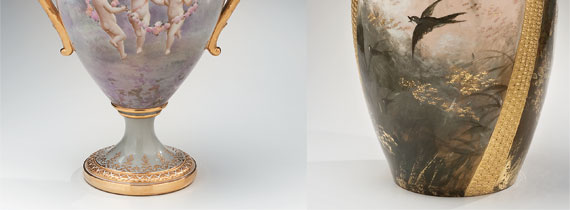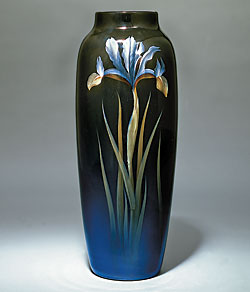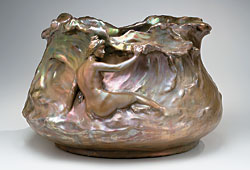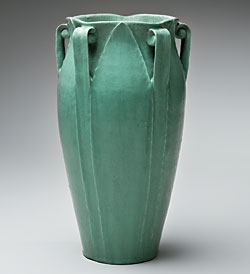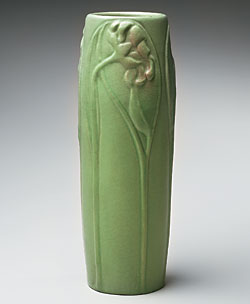ABOVE, LEFT: Fig. 1: Hans Nosek for Ceramic Art Company, Trenton, N. J. Two-handled vase with scenic decoration, 1905. Porcelain, enamel, gold. H. 17, W. 12, Diam. 8-1/2 in. Marked: Printed green mark, CAC in a wreath above LENOX. Gift of Brown-Forman, Incorporated, 2006 (2006.45.1). ABOVE, RIGHT: Fig. 2: Maria Longworth Nichols for Rookwood Pottery, Cincinnati, Ohio. “Oriental” vase, 1883. Earthenware with underglaze slip decoration. H. 20-1/2, Diam. 10-1/2 in. Marked: impressed on bottom, kiln-shaped stamp, G (ginger clay), ROOKWOOD / 1883. Purchase 1985 Mathilde Oestrich Bequest Fund and Eva Walter Kahn Bequest Fund (85.281). |
| by Ulysses Grant Dietz |
| The Newark Museum, founded in 1909, began collecting art pottery from the start. From its first art pottery exhibition in 1910 until the death of its founding director, John Cotton Dana, on the eve of the Great Depression, the museum was one of the nation’s pioneers in the exhibition of ceramics as art. For its centennial, the museum has mounted an exhibition that explores this idea, 100 Masterpieces of Art Pottery, 1880–1930. Artistic ceramics is not a new concept. However, in the third quarter of the nineteenth century, there was increasing reaction against industrial, “soulless” factory production coupled with a growing awareness in the West of revered ceramic traditions from Asia. All of this came together, for the United States at least, at the national Centennial Exhibition in Philadelphia in 1876. It was in the aftermath of the Centennial that Americans began to see the potential for transforming domestic ceramics from merely decorative objects into art objects—in their shape, glaze, and surface treatment. |
| The Arts and Crafts aesthetic that still tends to define art pottery today did not dominate the decorative arts in America in the early part of the twentieth century. The inclusion of Lenox china (Fig. 1) in the Newark Museum’s 1910 Modern American Pottery exhibition, alongside Grueby and Newcomb, reminds us that porcelain was also seen as art pottery. Walter Scott Lenox ran his Ceramic Art Company in the same way Rookwood and Grueby were run, with different segments of the production process assigned to specific people or groups of people, from glaze chemists and potters to kiln-loaders to decorators. His aesthetic goals were similar (to make art from clay), and his desire to balance art and commerce was the same. Like them, he was influenced by contemporary taste, and he was deeply involved in current ceramic technology. The art pottery business model involved divisions of labor, hierarchies of art and craft, and (of course) the balancing of art with profit. At the same time, however, the work of such pioneer studio potters as Adelaide Robineau, Frederick Walrath, and William Joseph Walley (in the United States) and Adrian Dalpayrat, Edmond Lachenal and Auguste Delaherche (in France) arose from the idea of making art first, profit second. Moreover, in Europe artists often worked in studio-like settings within factories (Christian Neureuther and Michael Powolny in Germany, Arthur Percy in Sweden). They produced ceramic objects that do not fit today’s idea of art pottery, but which were certainly collected as such in the 1910s and 1920s. |
| At the 1876 Centennial, Japanese and Chinese ceramics were seen by millions of visitors, as was the new “barbotine” decoration (painting under the glaze with liquid clay), perfected by Ernest Chaplet at the Haviland factory in Limoges, France.1 Two core concepts grew out of this moment relative to art pottery: the vessel as a canvas to be painted and the vessel as a sculptural object. Each would develop in its own way as the Gilded Age moved toward the twentieth century. China Painters & the Art Pot Art pottery was the offspring—or perhaps the sibling—of the china painting vogue that burgeoned in the last quarter of the nineteenth century. Maria Longworth Nichols (1849–1932), founder of the Rookwood Pottery, had started china painting in 1873, joining affluent women all over the country in this newly fashionable hobby. Dazzled by the Centennial Exhibition, and financed by her father, Nichols established her pottery in Cincinnati in 1880. It was America’s first official art pottery.2 Rookwood’s goal was to make pottery that was art, and to make that art commercially viable. The heavier technical work such as mixing clay, potting, and firing, was done by men, while the painting and decoration was done by both men and women, who were allowed to sign their pots. The early pots from Rookwood were strongly reflective of the Aesthetic movement and its fascination with Near- and Far-Eastern design (Fig. 2). The Rookwood technique of underglaze painting was developed from French “barbotine” or “Limoges” decoration. |
| Enameling on either porcelain or fine white earthenware was already a well-established tradition by 1876. European and Asia ceramic factories—from Satsuma, Japan, to Worcester, England—had specialized in exquisitely rendered floral decoration, landscapes, and mythological scenes since the development of low-fire enamels in the early eighteenth century. Enamellers generally worked on blanks designed and made by others; as was also true in art potteries, where ceramic decorators were kept apart from the potters and technicians. European art porcelain in the late nineteenth century mingled Japanism with other aesthetic influences. Royal Worcester’s ivory-bodied enameled wares (Fig. 3) were the standard against which American efforts at porcelain production were judged. The elaborate enameling and raised goldwork on Worcester porcelain paralleled similarly complex decoration on Japanese pottery and porcelain. English-born Edward Lycett (1833–1892) used his skills as a china painter to produce Worcester type ceramics at the Faience Manufacturing Company in Brooklyn in the 1880s.3 Considered the father of china painting in America, Lycett’s work demonstrated a close knowledge of both Japanese and English art pottery. The late twentieth-century appreciation of the Art Nouveau and Arts and Crafts styles marginalized the romantic decoration and gilded details of china-painted porcelain; but one shouldn’t forget that, to Walter Scott Lenox, who hired skilled European china-painters to decorate his vases, his porcelains were as much art as were Rookwood’s painted pots. |
| The Minimalist Art Pot The counterpoint to the exotic patterns and colors of Japanism in the 1870s were the monochromatic Chinese porcelains that depended entirely on simple forms and beautiful glazes. The Chinese displays at the Centennial Exhibition in 1876 were enormous, but they offered less novelty to American eyes, and caused a less obvious public sensation. The founding collection of the Newark Museum in 1909 was overwhelmingly Japanese, but it included a large number of Chinese monochrome porcelains. The importance of these minimalist form-and-glaze art pots has been underestimated by most recent scholarship. However, there is no question that from the 1890s to the 1920s, these minimalist art pots epitomized the ceramic artist’s attempt to capture the essence of pottery as art through the rediscovery of the primal beauty of glazed clay. Hugh Robertson and Adrien Dalpayrat exemplify the minimalist art potter at work on both sides of the Atlantic. In Massachusetts, Hugh Robertson (1845–1908) produced a line of austere Chinese-form vases with deceptively simple, richly textured glazes, in a wide range of colors. Never profitable, Robertson’s art pottery was subsidized by the popular blue and white crackled dinnerware lines developed in the 1890s that bore the Dedham name. His “volcanic” line was closer to studio pottery than art pottery, lacking the technical predictability that was a necessity for an art pottery that relied on consistency from the kiln.4 In France, Adrien Dalpayrat (1844–1910), who was born and trained as an artist and china painter in Limoges, focused on a high-fired (grand feu) vitreous stoneware (grès) body and simple forms covered with superb glazes (Fig. 4) that gained him a bronze medal in the 1893 World’s Columbian Exposition in Chicago and a gold medal in the Paris Exposition Universelle of 1900.5 |
| Even George Ohr (1857–1918) from Mississippi was clearly knowledgeable about Chinese forms and glazes. Ohr was the best thrower in the world in his day, and was the first American potter to push the art pottery envelope, manipulating his thin earthenware bodies in ways most Americans wouldn’t imagine until decades later (Fig. 5). He was also one of the first studio potters in America, working largely alone, and overseeing every aspect of his work directly. Both the commercially successful “Vasekraft” line of New Jersey’s Fulper Pottery (Fig. 6), and the hand-made, one-off porcelain gems of studio potter Adelaide Robineau (1865–1929) reflected a reverence for Chinese monochrome minimalism. Fulper, who showed at the Newark Museum in 1915, and Robineau, who sold three little pots to the museum in 1914 (the first acquisition by a museum of her work), used simple Chinese forms with carefully studied glazes achieved through much experimentation. Both Fulper and Robineau carried on the tradition of potters from the 1890s such as Robertson and Dalpayrat, but their output in the 1910s and 1920s reflects an ongoing interest in minimalist art pottery that was seen as modern in the 1920s. |
| The Painterly Art Pot The painted vase was the ideal ceramic art object, because, while functional, it did not have to serve a purpose other than contemplation. Stylistically, the vessel followed the aesthetic trends of the moment. In instances where the artist who decorated a pot and the potter who made it were not the same person (as was the case in almost every quasi-commercial art pottery), the decorative artist normally received the recognition, because his or her talents were seen as higher on the artistic scale than the manual skills of the potter. Rookwood exploited the reputations of its best artists (Fig. 7), as did European potteries such as Rozenburg in the Netherlands (Fig. 8) and Wachtersbach in Germany. On the other hand, art potteries limited the artistic freedom of their artists, requiring them to follow designs created by others and to stick to the general aesthetic guidelines that created the specific pottery’s “look.” The artists at Newcomb College Pottery in New Orleans were allowed some room to grow artistically––more, say, than their peers at Arthur Baggs’ Marblehead Pottery (Fig. 9)––but even they were circumscribed by the pottery’s overarching aesthetic goals and the need to sell. The eggshell porcelains produced at the Rozenburg factory in The Hague had to conform to the ethereal Art Nouveau style established as their main feature, and the pared-down stylizing adopted by Christian Neureuther’s studio at the Wächtersbach stoneware factory had to be commercially viable to survive. |
| The Sculptural Art Pot If the Centennial Exhibition in Philadelphia was a seminal event in the transformation of decorated ceramics into art; then it was equally the wellspring—in America at least—for the sculptural possibilities of ceramics. Professor Isaac Broome, working for Trenton’s Ott and Brewer, brought the artistic spotlight to ceramic sculpture in 1876.6 Broome, however, only made a few actual pots, preferring busts and figures. Just as was true with painterly pots, sculptural art pottery evolved as artistic taste and aesthetic ideology changed over time. Among the many European art potters who worked in sculptural ceramics, Clément Massier (1845–1917) established his first ceramic studio in 1872 in Vallauris in the Golfe Juan area of the French Riviera, and became famous for his metallic luster glazes (Fig. 10). Massier moved from the Japanism of the 1870s to the Art Nouveau of the 1890s, producing sculptural vessels that shimmered with surfaces unlike any other in the world. One student of Massier’s, Jacques Sicard, would take the secret of these glazes to America and build his own reputation with them in the early twentieth century. |
| The plainer, low-key translation of the sculptural qualities of the Art Nouveau in America is exemplified by the stylized foliage, simple outline, and silky matte glaze of Grueby pottery. A vase purchased by the museum in 1911 for half of its retail cost of $50 (Fig. 11), was modeled by Ruth Erickson (ca. 1899–1910), but, as was usually true in art potteries, her role in the artistic development of the vase was limited to the physical application of someone else’s designs. Inspired by French potters seen at international exhibitions, Grueby achieved huge success, winning a gold medal at the Paris exposition of 1900 and the Saint Louis exposition in 1904. Ironically, Grueby’s participation in the Newark Museum’s 1910 exhibition was the last public display of Grueby pottery in William Grueby’s (1867–1925) lifetime. For all his artistic success, the financial aspect of running an art pottery had eluded him. Former Rookwood decorator Artus Van Briggle was already long dead by the time his work was included in the Newark Museum exhibition in 1910 (Fig. 12). Van Briggle had adapted French art pottery’s low-relief sculptural effects and focus on superb glazes to the American market, slip-casting his designs and experimenting with innovative glazes.7 His enterprising widow continued to develop Van Briggle designs for decades after her husband’s death. With converse irony, Van Briggle’s commercial success has resulted in its artistic devaluation in the eyes of collectors and curators. |
| 100 Masterpieces of Art Pottery, 1880–1930 will run until January 10, 2010, at the Newark Museum. Art pottery, in all its manifestations between 1880 and 1930, is explored in the accompanying centennial catalogue. |
| |
| Ulysses Grant Dietz is curator of decorative arts at The Newark Museum, Newark, New Jersey. |
| |
| 1. Ulysses G. Dietz, “Art Pottery 1880–1920,” in Barbara Perry, ed., American Ceramics, The Collection of Everson Museum of Art (Syracuse and New York: Everson Museum of Art and Rizzoli, 1989), 61. 2. See Alice Cooney Frelinghuysen, “Aesthetic Forms in Ceramics and Glass,” in In Pursuit of Beauty, Americans and the Aesthetic Movement (New York: The Metropolitan Museum of Art and Rizzoli, 1986), 228. 3. He taught in Saint Louis and in Cincinnati, where he fired some of Maria Longworth Nichols’ own amateur china painted ceramics. See Alice Cooney Frelinghuysen, “Aesthetic Forms in Ceramics and Glass,” in In Pursuit of Beauty, Americans and the Aesthetic Movement (New York: The Metropolitan Museum of Art and Rizzoli, 1986), 426. 4. See Paul Evans, “Context and Theory, Binns as the Father of American Studio Ceramics,” in Margaret Carney, ed., Charles Fergus Binns The Father of American Studio Ceramics (New York City and Alfred, NY, Hudson Hills Press and New York State College of Ceramics at Alfred University, 1998), 103. Also Paul Evans, Art Pottery of the United States (New York: Charles Scribner’s Sons, 1974, reissued by Feingold & Lewis Publishing Group, 1987), 83. 5. See Henry-Pierre Fourest, L’Art de la Poterie en France de Rodin a Dufy (Sèvres, France: Musée National de Céramique, 1971), 25. Also see www.ceramique1900.com/dalpayrat.html and www.fr.wikipedia.org/wiki/Pierre-Adrien_Dalpayrat. 6. For a detailed history of early porcelain sculpture in America, see Alice Cooney Frelinghuysen, American Porcelain, 1770–1920 (New York: The Metropolitan Museum of Art, 1989), 166–179. 7. See Barbara M. Arnest, ed., Van Briggle Pottery, The Early Years (Colorado Springs: Colorado Springs Fine Arts Center, 1975), 65–66. |
Showing posts with label Newark Museum. Show all posts
Showing posts with label Newark Museum. Show all posts
Friday, November 5, 2010
When Pottery Became Art, 1880-1930
Subscribe to:
Comments (Atom)


